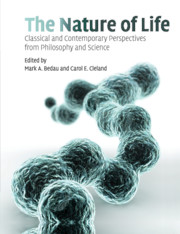Book contents
- Frontmatter
- Contents
- Preface
- Acknowledgments
- Sources
- About the authors
- Introduction
- SECTION I CLASSICAL DISCUSSIONS OF LIFE
- SECTION II THE ORIGIN AND EXTENT OF NATURAL LIFE
- SECTION III ARTIFICIAL LIFE AND SYNTHETIC BIOLOGY
- 16 Learning from functionalism: prospects for strong artificial life
- 17 Life, “artificial life,” and scientific explanation
- 18 Alien life: how would we know?
- 19 Automatic design and manufacture of robotic life forms
- 20 A giant step towards artificial life?
- 21 Approaches to semi-synthetic minimal cells: a review
- 22 Creating “real life”
- SECTION IV DEFINING AND EXPLAINING LIFE
- Supplementary bibliography on life
- Index
- References
16 - Learning from functionalism: prospects for strong artificial life
Published online by Cambridge University Press: 10 November 2010
- Frontmatter
- Contents
- Preface
- Acknowledgments
- Sources
- About the authors
- Introduction
- SECTION I CLASSICAL DISCUSSIONS OF LIFE
- SECTION II THE ORIGIN AND EXTENT OF NATURAL LIFE
- SECTION III ARTIFICIAL LIFE AND SYNTHETIC BIOLOGY
- 16 Learning from functionalism: prospects for strong artificial life
- 17 Life, “artificial life,” and scientific explanation
- 18 Alien life: how would we know?
- 19 Automatic design and manufacture of robotic life forms
- 20 A giant step towards artificial life?
- 21 Approaches to semi-synthetic minimal cells: a review
- 22 Creating “real life”
- SECTION IV DEFINING AND EXPLAINING LIFE
- Supplementary bibliography on life
- Index
- References
Summary
TWO USES FOR COMPUTERS
There are two quite different roles that computers might play in biological theorizing. Mathematical models of biological processes are often analytically intractable. When this is so, computers can be used to get a feel for the model's dynamics. You plug in a variety of initial condition values and allow the rules of transition to apply themselves (often iteratively); then you see what the outputs are.
Computers are used here as aids to the theorist. They are like pencil and paper or a sliderule. They help you think. The models being investigated are about life. But there is no need to view the computers that help you investigate these models as alive themselves. Computers can be applied to calculate what will happen when a bridge is stressed, but the computer is not itself a bridge.
Population geneticists have used computers in this way since the 1960s. Many participants in the Artificial Life research program are doing the same thing. I see nothing controversial about this use of computers. By their fruits shall ye know them. This part of the AL research program will stand or fall with the interest of the models investigated. When it is obvious beforehand what the model's dynamics will be, the results provided by computer simulation will be somewhat uninteresting. When the model is very unrealistic, computer investigation of its properties may also fail to be interesting.
- Type
- Chapter
- Information
- The Nature of LifeClassical and Contemporary Perspectives from Philosophy and Science, pp. 225 - 235Publisher: Cambridge University PressPrint publication year: 2010



